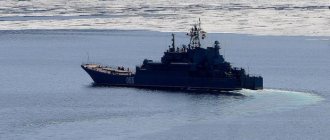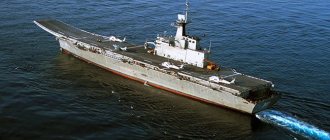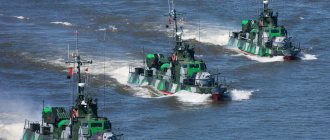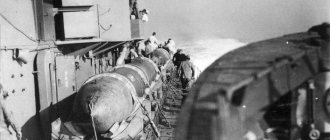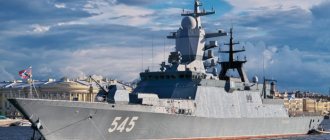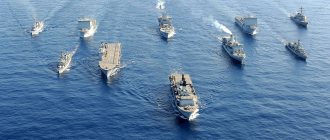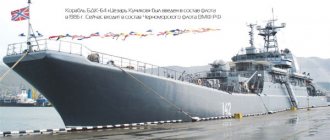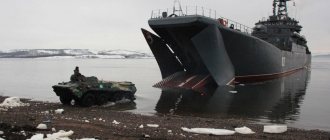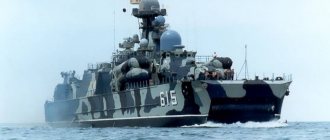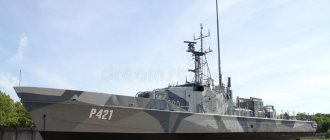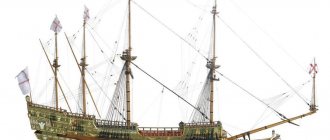United States Navy
A state that wants to defend personal interests anywhere in the world and influence the geopolitical situation must have a modern navy. The United States has been following a similar doctrine for almost a century. With the world's largest navy, the United States can project military power anywhere on the planet.
The US Navy includes a large number of aircraft carriers, submarines and surface ships. Receiving the most funding in the world, the fleet is constantly developing, and US naval hegemony will remain for a long time. The Navy is the foundation of the power of the United States, allowing any political and economic problems of the country to be solved by force.
An important point in the formation of a modern military fleet is the huge scientific and technical potential of the United States, working to modernize the Navy. Increasing the size and efficiency of the fleet has become one of America's major modern challenges. Gradually declining after the end of the Cold War, the US Navy began to rapidly accumulate power again with the beginning of the new century.
US Navy Composition
The organizational structure of the Navy has not been changed throughout the existence of the United States and is divided into two combat forces: the fleet and the marines, which also have a reserve. Acting together, these structures, however, have separate commands of their own. When the United States enters a war or declares a state of emergency, the Navy also includes the Coast Guard, which in peacetime is subordinate to internal security agencies.
The US Department of the Navy is the supreme administrative body of the country's structure of the same name. He is in charge of the entire range of tasks related to the implementation of daily activities, mobilization activities, logistics, personnel training and material and technical base. Under the leadership of the ministry, programs are being carried out to modernize combat units and their weapons, and repair work is being carried out.
The US Navy has maintained the structure and scope of missions since its formation.
The main body responsible for the operational management of the US fleet is the Naval Headquarters. The Chief of Staff is the de facto commander of America's entire Navy and is the President's adviser on the use of the Navy.
The Naval Headquarters includes various departments, such as the Naval Criminal Investigative Service and 4 inter-naval and 10 coastal commands. Norfolk is considered the main naval base.
The leadership of the US Navy is divided into:
- US Fleet Forces Command;
- Pacific Fleet;
- Navy in Europe;
- Sealift Command.
The command of the American Navy is carried out by a complex structure that has been formed throughout its history, taking into account the experience that the United States gained in World War II, especially Pearl Harbor. So the latest transformations in management occurred in 2006, when the status of the commander of the Atlantic Fleet was raised.
The US Navy is divided into 6 operational fleets: 2, 3, 4, 5, 6, 7 (1 fleet became part of 3 in 1973). The 10th fleet has no ships and is engaged in cyber intelligence and security.
They are equipped with combat and auxiliary ships. The personnel are staffed on a rotation basis, usually lasting six months.
2,4,6 fleets are subordinate to the Fleet Forces Command. All but the 6th fleet located in the Mediterranean Sea are stationed in the Atlantic Ocean, therefore they are also called the Atlantic Fleet.
The 3.5 and 7 fleets are stationed in the Pacific Ocean and are subordinate to the command of the fleet of the same name. Today it exceeds the Atlantic in the number of combat ships and other equipment.
US Special Forces. US Naval Special Warfare Command
SEALs of the 2nd Special Forces Group during an exercise, 2019
Special operations forces, which are directly subordinate to the U.S. Naval Special Warfare Command, are inferior in number to Army special forces and Air Force special forces. The total number of naval special forces personnel is estimated at approximately 10 thousand people, of which approximately a tenth are civilian personnel. The main striking force of the naval special forces are the “seals”, or “seals”, special reconnaissance and sabotage SEAL units, including combat swimmers.
US Naval Special Warfare Command
The US Navy Special Operations Command (United States Naval Special Warfare Command, abbreviated NSWC) in its modern form was formed on April 16, 1987.
Since its formation, the command's headquarters has been located at the Coronado Naval Base in San Diego (California). The same base is used by US Navy amphibious assault forces on the Pacific coast. The command provides operational leadership, planning and combat leadership of special forces units within the Navy. Currently, the US Naval Special Warfare Command is headed by Rear Admiral Collin Patrick Green. The backbone of the NSWC is made up of Navy SEAL teams, which are the main combat units and line units ready to engage in contact combat with the enemy. Next come the Special Boat Commands (SWCC) - members of the crews of landing craft, ships and special landing craft, who are responsible for the direct delivery of SEAL units to the operation site. They can provide support to SEAL units and other US special forces units. They are also trained in parachute landing along with their boats. Separately, we can distinguish two divisions of underwater carriers SDVT-1 and SDVT-2, which contain special equipment for the underwater delivery of Navy SEALs, including SDV MK8 underwater vehicles.
Emblem of the US Naval Special Operations Command
The third component of Naval Special Warfare Command is the enablers, or support personnel, ENABLERS. Unlike the two categories of Navy Special Forces listed above, it is not a direct action tool. First of all, highly qualified technical specialists in various fields are gathered here: communications, cryptology, mine engineering, etc. Directly subordinate to the US Navy Special Operations Command there are also educational institutions for training naval special forces and combat swimmers: a school for Navy special forces specialists, advanced training courses for special forces personnel and an adjunct course for the Naval Research Institute.
The elite of the US Navy special forces are, of course, the SEALs. For them, the state tries to provide the most comfortable level of social guarantees. The salary of recruits, according to the official website of the Naval Special Operations Command, starts from 60 thousand dollars per year (4,250,000 rubles at the current exchange rate) without taking into account bonuses for advanced training. Special forces also receive additional payments for diving and parachuting, a guaranteed 30-day annual leave, repayment of college loans, retirement after 20 years, medical insurance for the soldier and his family members and other benefits, including tax benefits.
SEAL Teams
SEAL is an abbreviation for Sea - sea, Air - air, Land - land, from English SEALs is translated as “seals”, but in the Russian language another definition is firmly entrenched - “fur seals”. These are the main tactical units of the US Navy special forces. Despite the fact that special forces are directly related to the fleet, as you can easily guess from the abbreviation itself, they are able to successfully operate not only at sea and can solve various tasks. Like many other American special forces units, their activities did not go unnoticed by Hollywood. A classic in this regard is the 1990 action film “Navy Seals” starring Charlie Sheen.
Navy SEALs practice in winter conditions
Navy SEALs are often called upon to carry out covert missions and sensitive tasks that do not require noise or publicity. They can penetrate operational areas using helicopters and fixed-wing aircraft, naval surface and submarine vessels, and ground vehicles. These are multi-role combat units, trained to operate in any conditions, they can be deployed anywhere in the world. SEAL special forces regularly went on business trips to Afghanistan and Iraq, where they always found work. Navy SEAL units also took part in Operation Desert Storm. Between 1990 and March 2018, these elite special forces units suffered 98 casualties during the wars in Iraq, Afghanistan and the war on terrorism, according to official data.
The main purpose of the Navy SEAL units is to conduct special, reconnaissance and sabotage operations in the interests of the fleet, as well as search and rescue operations. The units are able to act autonomously, solving combat missions independently, or in close cooperation with other units of US special forces. In addition to reconnaissance, sabotage and assault operations, SEAL units can also solve other tasks: covering the main forces, demining and mining ships, bases, terrain, adjusting artillery fire, combating maritime terrorism and modern piracy, combating illegal crossing of state borders at sea and etc.
Organizationally, the SEALs are organized into 10 teams, located within three special naval groups. The 1st and 2nd Groups, often referred to in the Russian press simply as the 1st and 2nd Navy Special Forces Regiments, each have 4 SEAL teams. The 1st, 3rd, 5th and 7th commands are part of the 1st group and are based at the Coronado naval base, they are focused on reconnaissance and sabotage operations in the Pacific Ocean. The 2nd, 4th, 8th and 10th commands are part of the 2nd Naval Special Forces Group, this group is headquartered at the Little Creek base in Virginia Beach (Virginia) and is focused on actions in the Atlantic Ocean. Two more SEAL teams, the 17th and 18th, form the 5th Naval Special Warfare Group, which serves as a reserve unit. The unit is also based at Naval Station Coronado in San Diego, California.
The total number of personnel of the 8 linear SEAL teams is approximately three thousand soldiers, including up to 600 people in the crews of landing boats and underwater landing craft. Another 325 people are in reserve as part of the 17th and 18th commands of the truncated strength, there are also approximately 125 members of the combat crews of landing craft and special delivery vehicles in the reserve and up to 775 reserve personnel from the US Navy Special Forces Logistics Regiment.
An interesting feature of the training of Navy SEAL teams is that each of them specializes in a specific theater of operations. Thus, some of the detachments are focused on operations in the jungles of South America and Indochina, some on the Middle Eastern theater of military operations and operations in desert conditions. At the same time, some of the teams are currently undergoing retraining for combat operations in the polar region.
Special Boat Commands (SWCC)
The most important part of the US Navy Special Operations Command is the Special Warfare Combatant-craft Crewmen (SWCC). They are responsible for the operation of small vessels that are used to deliver special forces to the shore. They provide combat operations in shallow water areas that are inaccessible to large ships, including along the coastline, on rivers and lakes. In addition to delivering “fur seals” to the shore, they can perform reconnaissance and patrol tasks, and are involved in search and rescue operations.
SWCC soldiers from a boat fire from a Mk19 automatic grenade launcher
In addition to direct training for operating boats and combat training, the fighters of the special boat team are prepared for parachute landing along with their boats. The teams also include trained medical workers who are ready to provide first aid to the wounded and injured in combat conditions or during evacuation, and are also ready to carry out emergency operations. Usually these are the leading medics of the squad. Moreover, all SWCC fighters, without exception, undergo constant repeated training in providing first medical and trauma care.
All SWCC fighters are consolidated into three flotillas: the 4th, 20th and 22nd as part of the 4th Special Forces Landing Craft Group. Special boat teams use small boats and landing craft, including simple semi-rigid inflatable boats of the RIB-36 type. Also in service are up to 20 Mark V SOC (Special Operations Craft) patrol boats with a displacement of 57 tons, 20 SOCR fast river boats and light PCA boats, for a total of about 240 boats and boats.
Prospects for the development of the US Navy
The existing development program involves a significant increase in ships and the number of naval forces. It provides for an increase in strike groups and warships. The priorities are aircraft carrier groups, renewal of combat units and the introduction of the latest landing ships.
The fleet is an integral part of the country's nuclear arsenal. Triden 2 ballistic missiles with nuclear warheads are deployed on Ohio-class nuclear submarines. 10 of them are constantly on duty. In accordance with the international treaty on the reduction of offensive weapons, 4 submarines have been converted to deploy Tomahawk missiles. In total, the US Navy has 53 submarines, putting America in a leading position. The Los Angeles-class submarines, which make up the majority of those on combat duty, are considered obsolete and are decommissioned as new submarine models arrive. The most modern of the submarines are the Sea Wolf submarines; at the moment their number is 3 units. In total, in accordance with the program for the development of the submarine fleet, it is planned to commission 32 submarines of this class.
However, nuclear aircraft carriers are still considered an unshakable symbol of America’s maritime superiority. They are the ones who help the United States participate in defending its global interests anywhere in the world, for example, Carl Vinson off the coast of Korea. Aircraft carriers are considered the centers of the US Navy's AUG. Each of which constitutes a major combat element of America's operational fleets. 10 Nimitz-class aircraft carriers serve in the Pacific and Atlantic fleets. Several ships were transferred for conservation. Last year, the newest type of aircraft carrier, the Gerald R. Ford, was put into service, which in all tactical and technical characteristics is superior to the aircraft carriers previously stationed at the post.
Such an aircraft carrier has a more modern power plant. The ship's crew is much smaller due to the introduction of modern management and maintenance technologies. The newest electromagnetic catapult has replaced the outdated steam catapult. All this made it possible to reduce the costs allocated from the budget for the maintenance of this combat unit compared to other aircraft carriers. In total, according to the plan, 3 ships of this class should be commissioned.
Each aircraft carrier has a stationed air wing consisting of several squadrons. Aviation stationed on an aircraft carrier can perform various functions. In addition to fighter-attack aircraft, there are aircraft equipped with electronic warfare and long-range radar detection devices that carry out reconnaissance operations. About 80 aircraft are deployed on aircraft carriers, some of which are operationally subordinate to the Marine Corps. In addition to aircraft, the aircraft carrier houses attack and anti-submarine helicopters.
Ship composition of the US Navy as of 01/01/2016 (statistics)
This publication is the first (not counting the “premature” ones on the Russian Navy and the PLA Navy) of the planned project of comparing the world’s navies to determine the real place of the Russian Federation among the 10 leading maritime powers - an unemotional comparison, in numbers, divided into two stages. At the first stage, it is planned to compare quantitative, “weight and size” and age characteristics, as well as the capabilities of military shipbuilding - respectively, in terms of total number, total and average total displacement (since the values of standard and normal are quite rare), average service life for 01/01/2016 and average construction duration). It is too early to talk about the second stage.
The presented statistical study takes into account everything that is called capital ships - warships of the main classes, plus landing ships and so-called littoral ships (which the author is inclined to consider corvettes), i.e. that component of the Navy that is capable of projecting power to remote regions of the world. At the same time, the US Navy is probably the only military fleet on the planet in which almost the entire ship composition falls under this definition, with the exception of Avenger-class minesweepers.
Ships under construction (not transferred to the fleet before 01/01/2016) are included in the initial data for reference - they are not taken into account either in the total number of ship personnel or in the total displacement. The names of the ships are given in Russian transcription, in most cases checked for compliance with the traditional spellings of geographical names, names and surnames of people in whose honor the naming was made.
10 statistical observations:
1) a colossal total displacement (about three million tons) - four times greater than that of its closest competitors (the Russian Navy and the PLA Navy - link 1);
2) about 30% of the total displacement falls on aircraft carriers, about half - on aircraft carriers, UDC and DVKD (which in the first case make up 5% , in the second - about 15% of the ship's composition);
3) a large average displacement ( 15,500 tons ), corresponding to a heavy cruiser (for the Russian Navy - a destroyer, for the PLA Navy - a frigate), which allows us to speak of the US Navy as a “fleet of large ships”;
4) a rather modest share of new ships (that entered service over the last 10 years ) - 21.5-23.5% (for the Russian Navy - about 10-12.5% - link 2), which is most likely close to “standard” for the share of new equipment (with the exception of some types of weapons) in any fleet that is steadily developing and operating for a long time);
5) not too strong (not “forever”) the gap from the Russian Navy in terms of the average age of the ship’s personnel ( 19 versus 25 years), which indicates both the difficulties of more frequent renewal and a well-developed ship repair capable of maintaining it in proper technical condition a large number of far from new ships;
6) minimal gap (essentially parity ) with the Russian Navy in terms of the average age of multi-purpose nuclear submarines, including SSGN/APKR ( 22.3 versus 22.9 years - these figures are not explicitly shown in the tables), with “only” two times ( 2.2 ) superiority in numbers ( 57 versus 26 ) - provided that our program for restoring the nuclear submarine fleet is fully implemented;
7) a significant (almost twofold ) gap from the Russian Navy in terms of the average age of ships of the destroyer class (including BOD) - the workhorses of the ocean fleet ( 14.3 versus 26.2 years) with an overwhelming (almost sixfold ) numerical superiority ( 62 versus 11 );
 questionable construction times for “small” littoral ships (moreover, increasing from the lead to the serial ones, and not vice versa), exceeding those for cruisers, destroyers and nuclear submarines;
questionable construction times for “small” littoral ships (moreover, increasing from the lead to the serial ones, and not vice versa), exceeding those for cruisers, destroyers and nuclear submarines;
9) the enviable and respectable average construction time of multi-purpose nuclear submarines and destroyers ( 3.65 and 2.77 years, respectively) is a benchmark to which we must strive;
10) the gap between the USSR and the USA in terms of the average duration of construction of warships of the main classes (including SSBNs/SSBNs) was only three months and a quarter ( 3.91 versus 3.64 years or 6.9 %) - a potential that needs to be restored at least in medium term.
Source data: in full view (5720 pixels vertically) - click on it.
Combat duty and strength
There is always one carrier strike group of the US Navy on combat duty, but sometimes their composition can reach up to 4. Before the advent and adoption of the Aegis system, most Navy ships were used in auxiliary roles. The ships assigned to the AUG carried out the functions of protecting the aircraft carrier. With the development of technology and weapons, the situation has changed dramatically. The newest system has the ability to detect long-range targets. The ships were equipped with vertical launch systems that can launch anti-aircraft, anti-submarine and cruise missiles. Having received new weapons, the ships were able, in addition to launching missile strikes on land, to carry out air defense and missile defense of ground and naval forces.
Previously, such functions could only be carried out using aircraft located on an aircraft carrier.
The American Navy has 22 cruisers equipped with the Aegis system and 2 vertical launch systems for 61 missiles. It is planned to gradually replace the Ticonderoga cruisers with more modern types of ships.
The main ship of the surface fleet is the Arleigh Burke class destroyer. There are currently 62 destroyers in service. It is planned to expand their composition to 100 units. In addition to the Aegis control system, each destroyer is equipped with a Mk 61 installation and carries approximately 90 missiles. 22 such ships are part of the missile defense system.
The newest destroyer Zumwalt, which has a non-standard appearance due to the applied Stealth technology, should replace them. However, although it was planned to put 32 ships of this type into service, only 3 are planned to be produced, which is primarily due to the unreasonably high cost, which causes criticism. The Zumwalt incorporates many of the latest technologies, such as a railgun.
American frigates of the Oliver Perry class are not considered particularly successful ships, but there are 15 such ships in service and 16 are being mothballed. In accordance with the plans, all of them are going to be excluded from the fleet.
Considering the country's strategic directives, the Navy has only 2 corvettes. Operating effectively in coastal waters, they did not fit into the overall strategy of warfare. They began to be developed and built quite recently. Considering their high cost, a significant increase in their number is most likely not expected.
Given its geographical location and the desire to actively participate in defending personal interests, the United States has the largest number of landing ships that can land special forces, including.
The US Navy's Avenger minesweepers are located only in the Pacific Ocean.
Naval Aviation
In addition to ships, the US Navy also includes aviation, which is still the main striking force. Aviation is divided into subordinate navy and marine corps. The F/A-18 Hornet is considered the premier combat aircraft. Timely updated, it has excellent combat characteristics. Approximately 1,000 units are constantly in service, and there are also aircraft in conservation.
The Marine Corps has 138 Harrier aircraft at its disposal, which the Americans have undergone significant modernization. It is planned to gradually replace them with more modern F-35s.
The P-8A Poseidon anti-submarine aircraft, presented so far in the amount of 19 units, are replacing the outdated Orions. Their number is planned to be increased to 117 units.
Electronic warfare is carried out from EA-18G aircraft. About 100 such devices are already in service and their number should be increased.
The aircraft designed to provide long-range radar detection, the E-2C Hawkeye, is represented by 61 copies.
An unusual aircraft is the MV-22B Osprey tiltrotor. The Navy has 184 copies capable of taking off and landing like a helicopter, possessing the high-speed qualities of an airplane in flight.
The Russian EKIP is considered even more unusual. Several years ago, news was announced in the media that a Russian flying saucer was intended to serve in the US Navy.
In addition to airplanes, aviation is represented by helicopters for various purposes, from transport to minesweepers.
The Marine Corps, which is part of the Navy, in addition to aviation, is armed with ground armored vehicles and artillery weapons. Marine special forces can be armed with MANPADS and other weapons. With such powerful weapons, having 4 divisions, the US Marines are stronger than many armies of individual states.
Combat operations
While pursuing a policy of active intervention in international affairs, the United States has repeatedly used the Navy as a means of persuasion. At the moment, due to the aggravated situation, the aircraft carrier Carl Vinson is at the head of the US Navy off the coast of North Korea. The group is intended to put pressure on the leadership of the DPRK, which authorizes the launch of ballistic missiles and the testing of nuclear weapons.
The operations assigned to the US Navy were not always successful. Thus, Operation High Jump, planned in 1946, with the goal of destroying Base 211, began in 1947 and was not completed. The media reported that during Operation High Jump, the Americans suffered losses from an unknown enemy and were forced to return.
Considering that Japanese aircraft, having bombed Pearl Harbor, practically destroyed the US Pacific Fleet in one day, it is worth saying that the level of its combat effectiveness was not always at its best.
In addition, the leadership of the Navy has been repeatedly criticized due to frequent clashes with foreign ships. In particular, in 1988, a collision between US and USSR navy ships occurred in the Black Sea.
However, despite minor shortcomings, the US fleet has been and remains an important lever of influence on geopolitical processes in the world.
We take everything from the British
The United States Navy, for obvious reasons, inherited the rank system of the British Navy (the Japanese, by the way, also loved Britain). The subsequent evolution of this system also took place with an eye on the former metropolis. As a result, even after more than a century and a half of independence, by the beginning of World War II, the line of officer and admiral ranks of the US Navy was almost completely identical to the British.
But the insignia was already quite seriously different, although it remained very similar. The first thing that catches your eye is the absence of the “British ring” characteristic of many navies on the upper braid of the sleeve insignia and shoulder straps. Also, rank badges on the collar, which were absent from the British, appeared, completely similar to those in the army.
In 1943, American shipyards began churning out ships in such quantities that the question arose of who would command their formations. Producing so many people into rear admirals in the fleet was simply a toad's pressure. Therefore, the rank of commodore was temporarily returned - “under-admiral” with one star, which existed until the end of the war, and was again canceled in 1947.
By the end of 1944, there was already a noticeable smell of victory in the air, and the United States began to think about encouraging the most distinguished commanders and naval commanders. Moreover, in the armies and navies of their allies there were people higher in rank than them, which is unacceptable! As a result, several “five-star” Army generals and Navy admirals emerged. These honorary titles are awarded only during war.
Since both of these titles had not yet appeared in my beloved year 1942, I did not draw them.
